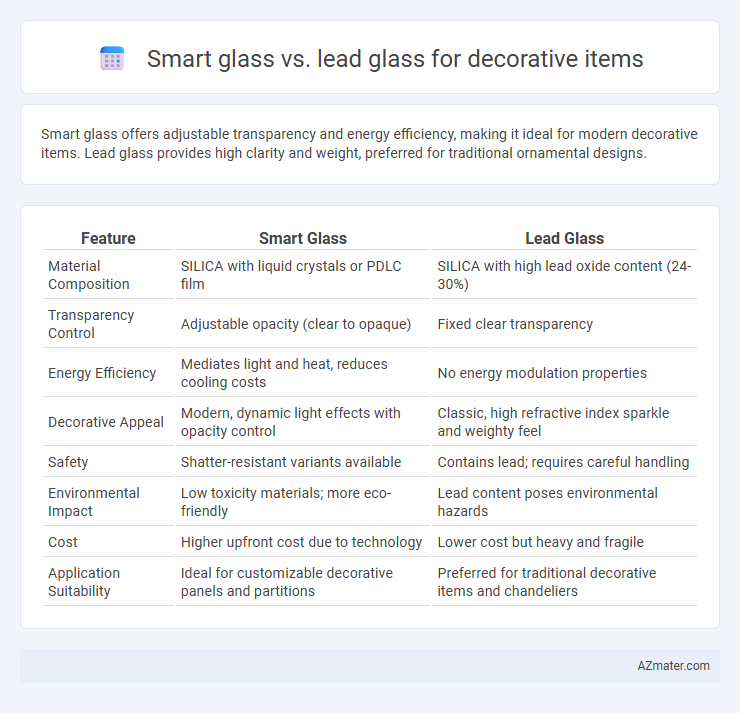Smart glass offers adjustable transparency and energy efficiency, making it ideal for modern decorative items. Lead glass provides high clarity and weight, preferred for traditional ornamental designs.
Table of Comparison
| Feature | Smart Glass | Lead Glass |
|---|---|---|
| Material Composition | SILICA with liquid crystals or PDLC film | SILICA with high lead oxide content (24-30%) |
| Transparency Control | Adjustable opacity (clear to opaque) | Fixed clear transparency |
| Energy Efficiency | Mediates light and heat, reduces cooling costs | No energy modulation properties |
| Decorative Appeal | Modern, dynamic light effects with opacity control | Classic, high refractive index sparkle and weighty feel |
| Safety | Shatter-resistant variants available | Contains lead; requires careful handling |
| Environmental Impact | Low toxicity materials; more eco-friendly | Lead content poses environmental hazards |
| Cost | Higher upfront cost due to technology | Lower cost but heavy and fragile |
| Application Suitability | Ideal for customizable decorative panels and partitions | Preferred for traditional decorative items and chandeliers |
Introduction to Decorative Glass: Smart Glass vs Lead Glass
Smart glass offers dynamic opacity control through electrochromic technology, making it ideal for modern decorative items that require privacy and light modulation. Lead glass, renowned for its high refractive index and brilliance, remains a classic choice for ornamental pieces emphasizing clarity and intricate craftsmanship. Both materials enhance decorative aesthetics, but smart glass integrates technological innovation while lead glass emphasizes traditional elegance.
Material Composition: Smart Glass vs Lead Glass
Smart glass primarily consists of multiple layers including glass substrates and an embedded electrochromic or liquid crystal film that alters transparency when voltage is applied, offering dynamic light control. Lead glass, or lead crystal, contains a high percentage of lead oxide (typically 24-30%), which enhances its refractive index and weight, producing brilliant light dispersion ideal for decorative items. Material composition differences influence durability, optical clarity, and functionality, making smart glass suitable for adaptive decor and lead glass prized for its traditional brilliance and luxury appearance.
Aesthetic Versatility in Decorative Items
Smart glass offers dynamic aesthetic versatility in decorative items by allowing customizable transparency and color changes, enhancing modern design flexibility. Lead glass, known for its brilliance and clarity, provides a timeless, luxurious appearance with intricate patterns and light refraction ideal for classic decorative pieces. Smart glass supports interactive and adaptive decor, whereas lead glass excels in traditional elegance and ornamental craftsmanship.
Light Control and Transparency Features
Smart glass offers dynamic light control by adjusting transparency in response to electrical current, allowing users to switch between opaque and clear states for privacy and ambiance. Lead glass provides high clarity and brilliance with excellent transparency but lacks the ability to modulate light transmission actively. For decorative items, smart glass enhances functionality through adaptable light filtering, while lead glass excels in static clarity and ornate design details.
Durability and Maintenance Comparison
Smart glass features advanced durability with scratch-resistant coatings and UV protection, making it highly resistant to wear and environmental damage. Lead glass, while elegant and dense, is more prone to scratches and requires careful handling and specialized cleaning to maintain its clarity. Maintenance for smart glass is simpler, involving only regular wiping with non-abrasive cloths, whereas lead glass demands gentle cleaning agents to avoid surface degradation over time.
Safety and Environmental Impact
Smart glass offers enhanced safety features due to its ability to switch from opaque to transparent, reducing glare and preventing accidents, while lead glass contains toxic lead that poses significant environmental hazards during production and disposal. Unlike lead glass, smart glass uses non-toxic materials, making it a more eco-friendly option that reduces harmful waste and environmental pollution. Its energy-efficient properties further minimize environmental impact by regulating indoor temperatures and reducing the need for artificial lighting.
Customization Options for Interior Design
Smart glass offers dynamic opacity adjustment and color-changing features, enabling customized ambiance and privacy levels in interior design. Lead glass, known for its intricate patterns and color variations, allows artisans to create bespoke decorative pieces with enhanced brilliance and traditional elegance. Both materials provide unique customization options, but smart glass excels in adaptability while lead glass emphasizes artistic detail.
Cost Analysis: Smart Glass vs Lead Glass
Smart glass typically incurs higher initial costs due to advanced materials and installation technology, often ranging from $50 to $100 per square foot, compared to lead glass, which averages $30 to $50 per square foot depending on thickness and design complexity. Maintenance expenses for smart glass can be lower over time since it reduces the need for additional shading or window treatments, while lead glass may require more upkeep to preserve its clarity and decorative appeal. Evaluating long-term investment, smart glass offers energy-saving benefits that can offset upfront costs through lower utility bills, whereas lead glass primarily enhances aesthetic value without contributing to energy efficiency.
Popular Applications in Decorative Settings
Smart glass is popular in decorative settings for dynamic privacy control, energy efficiency, and customizable light modulation, often used in restaurant partitions, hotel lobbies, and office interiors. Lead glass, renowned for its brilliance and weight, remains favored in artisanal stained glass, luxurious chandeliers, and ornamental sculptures where high refractive indices enhance visual impact. Both materials serve distinct decorative applications, with smart glass excelling in functional design elements and lead glass prized for classic elegance and optical clarity.
Choosing the Right Glass for Your Decorative Needs
Smart glass offers dynamic opacity control and energy efficiency, making it ideal for modern decorative items requiring privacy and light modulation. Lead glass, known for its brilliance and high refractive index, enhances aesthetic appeal with vibrant clarity and weight, perfect for traditional decorative objects like chandeliers and vases. Selecting between smart glass and lead glass depends on whether functionality or visual elegance is the priority in your decorative design.

Infographic: Smart glass vs Lead glass for Decorative item
 azmater.com
azmater.com